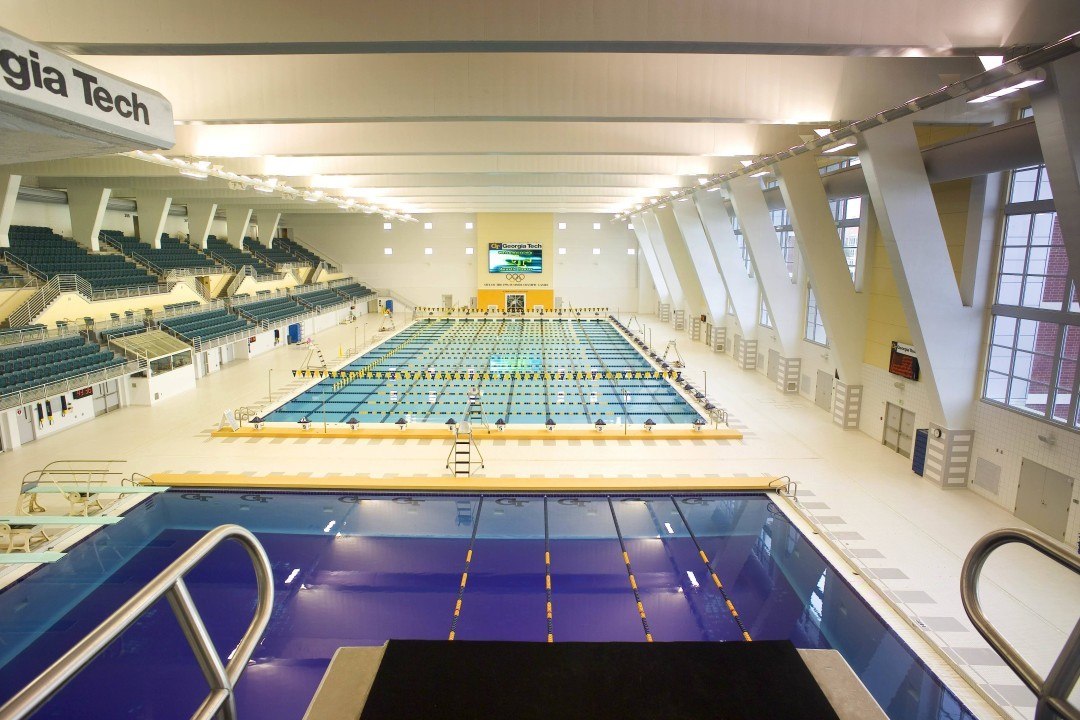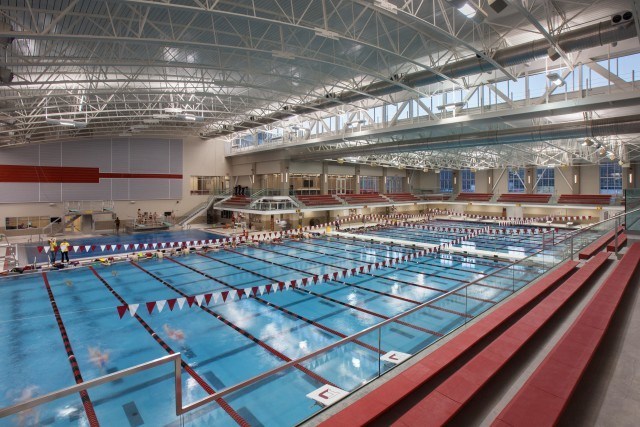Courtesy of Counsilman-Hunsaker. Written by Scott W. Hester.
Spectator seating is universally associated with competition in any sport and can often become a hot button topic in a natatorium. It seems like everyone has their opinion. Topics such as quantity of seats, type of seating, location of seating, permanent versus portable, and spectator viewing angles arise when making this important decision. While there is some level of subjectivity when making these decisions, make no mistake these choices can have a significant impact on your facility.
To start the discussion, one must determine the preferred viewing direction for aquatic sport events. While there have been natatorium designs that have incorporated 360 degree peripheral seating, you’ll find that in a natatorium environment the spectator’s viewpoint is preferred to be congruent with the field of play. Therefore, unlike the major sports, spectator seating for aquatic sports is almost always located parallel with the field of play. This allows spectators to fully follow the swimming event from end to end. For pools that include race courses in multiple directions such as a 50-meter by 25-yard pool, seating along two sides of the pool might be preferred. This type of spectator seating configuration would be a consideration when the primary 25-yard racecourse is across the pool in the short course direction. Under these somewhat unique conditions, providing spectator seating along multiple pool sides should be provided. Other aquatic sports such as water polo and synchronized swimming have also traditionally preferred spectator seating that is parallel with the field of play. While some fans may actually prefer a frontal view for diving, industry precedence has been to maintain viewing for springboard and platform diving from the side as well.
As with other sporting events, ensuring that each spectator has the ability to adequately see the entire field of play is critical to the fan experience in a natatorium. The line of site, or viewing angle of the spectator seating is another key design element for consideration. Ideally, each spectator will be able to view the entire pool without standing or repositioning oneself to view beyond the spectators sitting in front of them. To achieve this, ample deck space will be needed to provide clear lines of site to the pool. This becomes particularly critical in facilities with elevated seating. Lines of site may require deck spacing up to 20 feet, which can have major implications on costs of the facility. If budget is a concern, deck level seating might be the only option. Deck seating is usually found in smaller natatoriums containing only short course pools (i.e., 25-yard and 25-meter). For locations that provide only deck level seating, control of spectators becomes a key part of the design as multiple entrance/exit points will be required.

Gateway Aquatic Center (courtesy of Gateway Aquatic Center – Ketchikan, AK – Ken Graham Photography / Counsilman-Hunsaker)
Considering that natatoriums are warm and humid environments that can wreak havoc on building materials and finishes, material selections are important. As expected, non-corrosive equipment should be selected, and in some instances, concrete step seating may provide sufficient seating with offering the advantage of low maintenance. In addition to material selections, other issues to be considered include: costs, ability to convert spectator seating space to multi-use space, frequency of competition events, emergency exit requirements, density of spectators, and requirements for parking to seating ratios.
When determining the total quantity of spectator seating, several factors may have influence. Besides budget, the biggest influencing factors on seating size are the size of pool and expected events. A typical seat count for a short course pool (25-yard or 25-meter) natatorium is 125-250 seats. Facilities hosting multi-team meets will usually require 250 to 500 seats. Since these events are infrequent, a combination of permanent and temporary seats is the most cost-effective solution. Some pools are in locations with many age group teams that desire the ability to frequently host large multi-team meets. These facilities can justify 500 to 1,000 combined seats. A long course pool (50-meter) that will host major competitions, will typically require a minimum of 1,000 permanent seats, with space for installing additional temporary seats. Larger attendance may occur for a United States age group invitational meet. Universities that wish to attract the National NCAA Championship meets frequently provide 1,500 to 2,500 seats made up of both permanent and temporary seats. Major international swimming events such as the FINA World Championships or Pan American Games would typically require 7,500 to 10,000 seats. At the top of the scale are Olympic venues for aquatic sports with a requirement of 15,000 to 20,000 seats.
As you can see, designing the appropriate spectator seating location, style and quantity involves many considerations. Not unlike most sporting events, spectators can influence the results of aquatic competition. Providing ample space for spectators in a friendly and comfortable environment is critical. All factors should be considered by developing a list of preferred solutions that are prioritized and matched to fit your budget.
The above is an excerpt from an article that appeared in the May 2015 issue of Athletic Business with the title “Spectator Splash.” The complete article can be found here.
ABOUT US: COUNSILMAN-HUNSAKER
The history of Counsilman-Hunsaker is valuable in the context and the confidence it provides. Over the past 45 years, we’ve led the industry by completing more than 1,000 national and international aquatic projects of every size and complexity. In fact, many of the innovations that are now standard in the industry were conceived by our team.
Counsilman-Hunsaker believes that people of all ages are changed for the better through aquatic experiences and that our services reach beyond just solving design, or engineering or facility operational challenges. Our mission is to create aquatic experiences that transform people and communities, which supports our mantra of “Aquatics for Life”. And when we say “Aquatics for Life” we’re talking about the lives of humans we serve through every decision from conception, to the detail of daily operations. By focusing and serving the human experience, our full circle approach to everything we do allows us to be your guide every step of the way from facility audits, to program and design, thru facility creation and day to day operations.
Along the way, we’ve developed an international reputation for innovation and integrity, as people who are passionate about what they do and who do it exceptionally well. Today, our firm consists of an integrated team of designers, engineers and operational specialists with incomparable aquatic industry experience.
COUNSILMAN-HUNSAKER LINKS
SIGN UP FOR COUNSILMAN-HUNSKAER’S NEWSLETTER
CHECK OUT COUNSILMAN-HUNSAKER ONLINE: CHH2O.COM
LIKE US ON FACEBOOK
FOLLOW US ON TWITTER
CHECK OUT OUR AQUATIC INDUSTRY BLOG: HYDROLOGICBLOG.COM
WE DO MORE THAN COMPETITIVE POOLS: SEE OUR PAST PROJECTS
Swimming News and photos courtesy of Counsilman-Hunsaker, a SwimSwam partner.






I’ve never known any fans who prefer frontal viewing for diving.